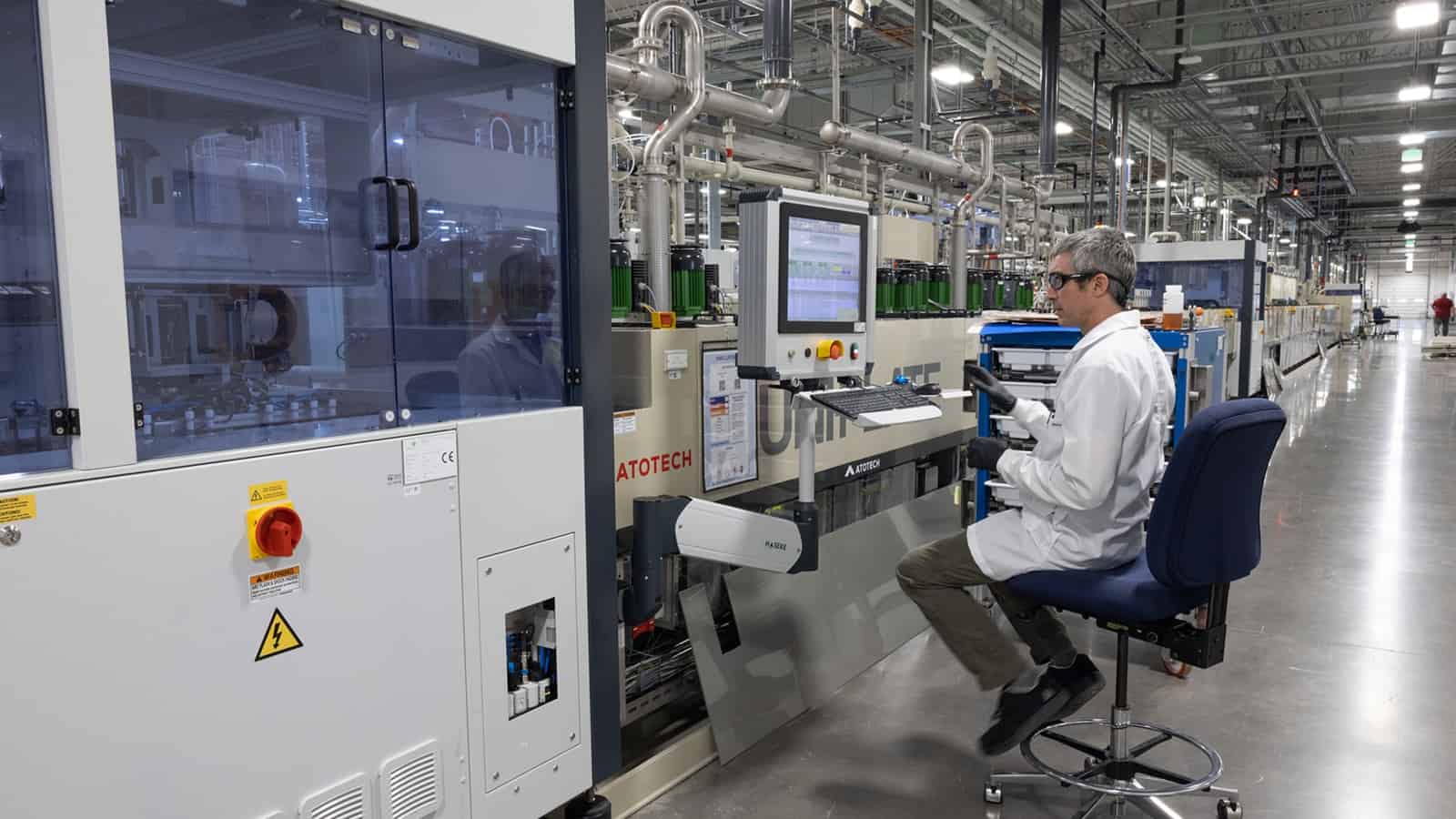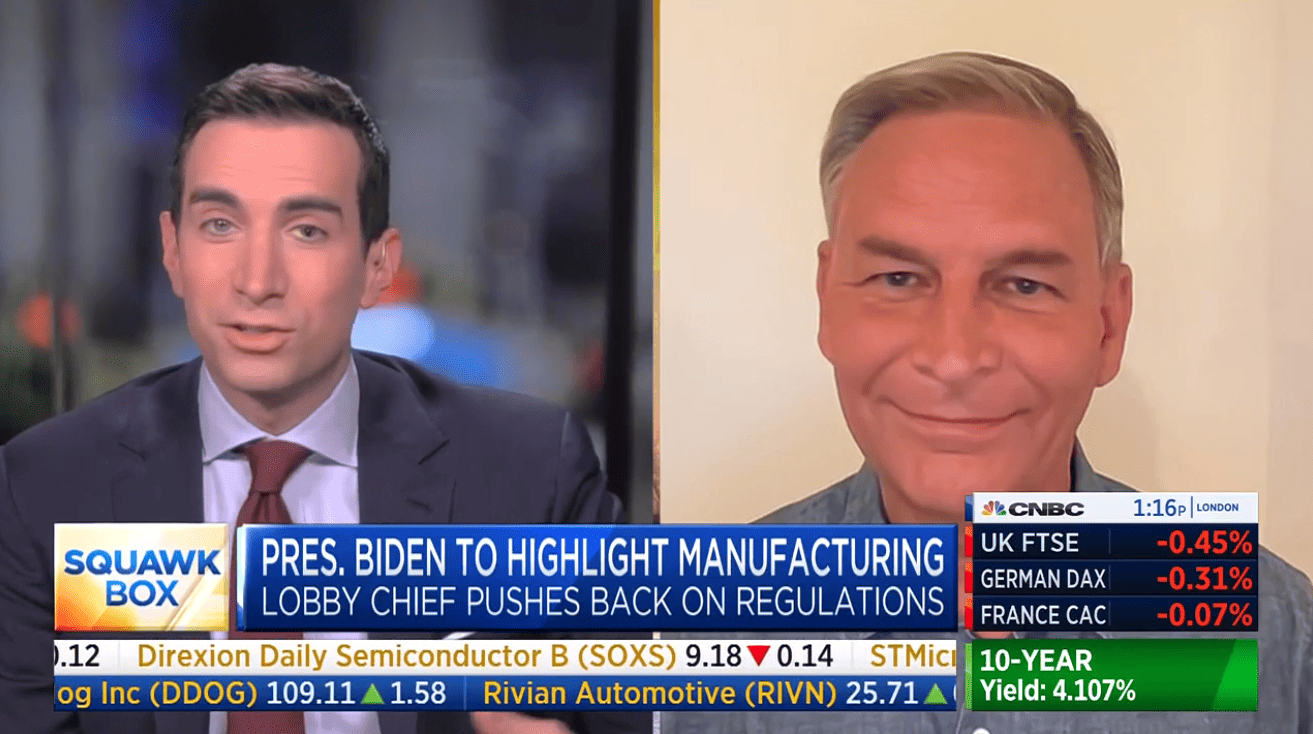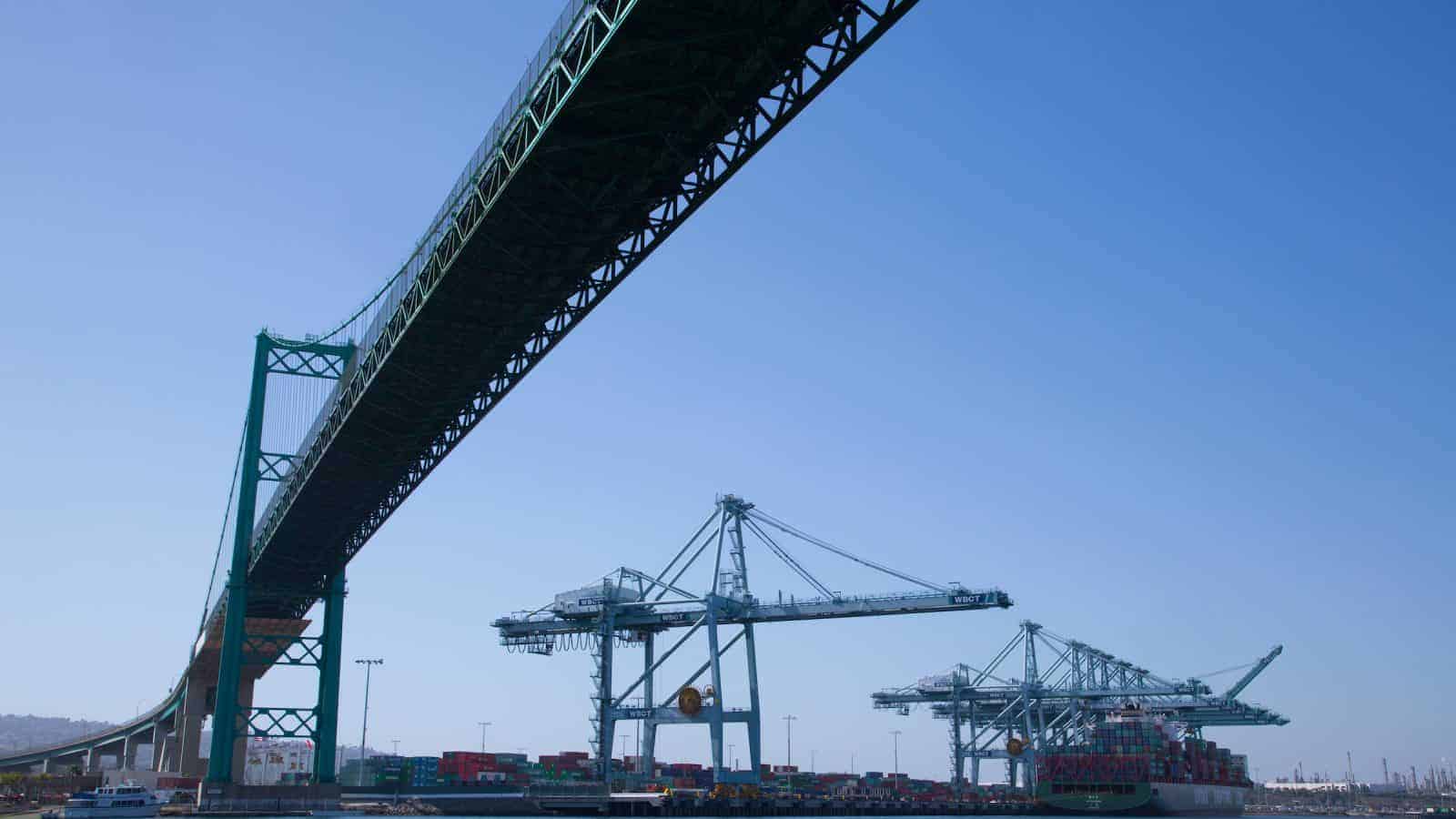PALIoT Takes on Supply Chain Challenges

Supply chain problems, PALIoT Solutions is coming for you.
This fall, the New-York-state-based startup, whose name derives from a combination of “pallet” and “IoT,” will begin production of its smart shipping pallets. According to company leaders, these products will do nothing less than revolutionize the way food and goods are transported.
From vision to reality: PALIoT cofounders Paul Barry and Richard MacDonald envisioned pallets “whose positive impact on the environment keeps increasing as more of them are manufactured and deployed,” according to the firm’s website.
- To accomplish this feat, the pallets had to be both far lighter and more durable than typical pallets, which are made of wood and nails.
- After significant research and development, Barry and MacDonald came up with the solution: a polyurea-coated, engineered-plywood pallet that was 20 pounds lighter than its traditional peers and contained a proprietary sensor capable of instant communication with the cloud, making inventory tracking a cinch.
The “secret sauce”: “The ‘secret sauce’ is essentially a smart mesh network,” said Barry, who hails from Ireland and has an electrical engineering and investment banking background. “The PALIoT pallets in a shipment will all talk to each other, say, ‘Hey, I’m here.’ And [after shipping,] because they know they’ve been on a truck, they know they have to report all that valuable inventory and environmental data back to the cloud.”
- PALIoT, which will rent its pallets to customers using a per-pallet, pooling model (with an optional subscription service), acquired exclusive global use of the mist® Mesh Networking protocol. This ensures that communication is highly secure and battery sensitive at all times.
- The company estimates it will initially produce between 650,000 and 700,000 pallets a year in the first phase of the launch.
Read the full story here.
West Coast Dockworkers Ratify Contract

Late last week, West Coast dockworkers voted to ratify a long-term employment contract that was agreed upon earlier this summer, The Wall Street Journal (subscription) reports.
What’s going on: Approximately 75% of International Longshore and Warehouse Union members voted in favor of the six-year labor contract with the Pacific Maritime Association.
- This ratification vote formalizes the tentative agreement reached in June, which was preceded by several brief work stoppages, and is the culmination of negotiations that began in May 2022.
- “The ILWU represents about 22,000 workers at 29 ports from California to Washington state.”
Why it’s important: These negotiations, which ultimately took 14 months to resolve, were at times tumultuous, and the resulting supply chain disruptions led to a significant loss of West Coast cargo business to the East and Gulf coasts.
- Together the ports of Los Angeles and Long Beach constitute the busiest ocean trade gateway in the U.S., handling almost 40% of U.S. imports from Asia, according to the Los Angeles Times.
- The NAM consistently advocated for a resolution to these talks and commissioned an economic impact study in 2022 that found even a 15-day shuttering of these two West Coast ports would cost the U.S. economy nearly half a billion dollars a day and 41,000 jobs.
The NAM says: “Ratification of this six-year contract provides manufacturers with the supply chain reliability they need for operational planning and stability,” said NAM Director of Infrastructure and Labor Policy Ben Siegrist.
- “NAM members have overcome countless shipping challenges over the past few years and were at the forefront of calling for this resolution. We are pleased the contract has been ratified.”
DOE Proposes Power-Line Fast Tracking

The federal permitting process for major transmission lines should soon get a lot easier to navigate, according to POLITICO’s ENERGYWIRE (subscription).
What’s going on: Last Thursday, the Department of Energy proposed “completing environmental reviews and other federal approvals for electric power lines within two years.”
- In addition, “DOE would be the lead agency conducting environmental impact statements and other federal reviews for transmission projects so that developers wouldn’t need to go through multiple federal agencies.”
- Once finalized, the framework will be called the Coordinated Interagency Transmission Authorization and Permits Program.
Why it’s important: The draft revision—a response to the recent debt-ceiling deal—could slash the time it takes to get long-distance power lines built and operational.
- This “could help integrate more solar and wind into the U.S. energy resource mix,” according to ENERGYWIRE.
- Though Congress authorized the DOE as lead federal agency in reviewing electric power lines, this proposal marks the first time the authority has been “formally proposed,” a source told the news outlet.
Developers’ role: The proposal details what developers would have to do under the new process.
- “For example, DOE would require developers to complete resource reports about potential environmental impacts from construction or operation of their projects. Applicants would also need to submit plans for engaging with communities affected by a new transmission line.”
However … CITAP wouldn’t cancel the need for local and state permits.
- “Rather, the goal is to ensure that developers have a clearer and smoother process for obtaining necessary federal permits.”
The NAM’s take: “This is a step in the right direction,” said NAM Vice President of Domestic Economic Policy Brandon Farris. “As part of our push for permitting reform, the NAM has long advocated for a lead federal agency to run point and streamline the permitting process.”
- “The NAM will continue to work with Congress and the administration to make the permitting process more predictable and consolidate the many complex layers of review so the U.S. can continue to build on our shared goals of boosting domestic manufacturing.”
A Homegrown Solution: Schweitzer Engineering Laboratories Makes Printed Circuit Boards

With one of its key components—printed circuit boards—in short supply, Schweitzer Engineering Laboratories chose the proactive solution: it would begin making them itself. Now that its new factory is up and running, SEL is receiving unexpectedly keen interest from other companies, and considering ramping up production for outside sales.
Fixing a supply chain problem: The Pullman, Washington–based electric power system protection solution manufacturer began manufacturing PCBs at its new $100 million, 162,000-square-foot factory in Moscow, Idaho, back in March.
- “Printed circuit boards take electronic components and interconnect them so they can interact with each other,” SEL CEO David Whitehead said. “Without them, you can forget about AI, forget about your cell phones—they’re in just about any electronic device.”
- The Moscow factory is running at about 25% capacity. When it reaches full production later this year, it will be one of the top PCB manufacturers in the U.S., according to Whitehead.
Domestic and accessible: The PCB “is a critical component that goes into our devices,” Whitehead continued. “Now, instead of sourcing PCBs from around the U.S., we can produce them ourselves.”
- The Moscow facility—which only produces the circuit boards for SEL—has increased the company’s supply chain resiliency and sped up its output, Whitehead told us. “Now, in a handful of days after designing a printed circuit board for a product, our engineers are in their labs testing it. It’s a big win for us.”
- Nearly half of manufacturers in the U.S.—44.9%—cite supply chain hurdles as one of their top business challenges, according to the NAM’s Q2 2023 Manufacturers’ Outlook Survey.
Self-funded and viable: SEL funded 100% of the facility’s construction costs, and it will have paid for itself in two to three years, Whitehead said.
- “I think that’s really a big deal for not only taxpayers but the local community generally,” he said. State and local governments “can take the funds [they didn’t use on us] and invest” elsewhere.
A good neighbor: The Moscow plant—which features a fume scrubber system that exceeds Environmental Protection Agency standards for volatile organic compounds—also uses a “zero-liquid discharge water treatment system that recycles and reuses all the water used to manufacture the printed circuit boards,” Whitehead said.
- A comparable factory would use about 90,000 gallons of water each day of production, while SEL uses about 500 to 600 gallons—the equivalent of only a few households’ daily usage, according to Whitehead. Most of that is for worker needs (drinking water and restrooms).
- The company also reclaims and reuses metals, such as tin, silver and gold, that are used in the production process.
- “We are very environmentally conscious about how we produce these boards,” Whitehead said.
What’s next? Since the facility began production, SEL has gotten numerous inquiries from other manufacturers interested in buying the PCBs. The company is likely to oblige them soon.
- “This is our next opportunity,” Whitehead said of producing boards for other manufacturers. “We love being vertically integrated, building as much as we can close to where we’re going to use the products. … As we get better at it for our own consumption, I can see us expanding it.”
DOE to Announce Carbon-Removal Project Winners

The Biden administration will soon announce the first grant winners of a multi-billion-dollar competition to speed up development of technology to “remove carbon dioxide from the sky,” according to E&E News’ CLIMATEWIRE (subscription).
What’s going on: The “awards for so-called direct air capture hubs could define the future of the nascent DAC industry in the United States as well as the broader CO2 removal sector, experts say.”
- The Department of Energy received more than a dozen proposals in response to the $3.5 billion DAC hub competition, which was created in 2021 as part of the historic bipartisan infrastructure legislation and seeks to increase the use of DAC technology.
- The projects expected to be announced this month could get “between $3 million and $500 million in matching funds” for efforts such as DAC undertakings capable of capturing and storing one million tons of carbon dioxide every year.
What it is: DAC plants use filters, power, piping and fans to remove carbon dioxide from the air and sequester it underground.
- Just 27 such facilities have been commissioned globally, and the largest of these can remove 4,000 tons of carbon dioxide from the atmosphere annually.
The economic challenge: “At the moment, it costs around $700 per ton for a DAC facility to remove carbon from the air, according to the industry data clearinghouse CDR. The Inflation Reduction Act, meanwhile, increased the tax incentives for DAC operators to $180 per ton for the CO2 they permanently store.”
- To bridge that cost gap, last year Congress ordered the Biden administration to start a pilot program to pay DAC firms and developers of carbon-removal technology to remove emissions from the air.
The final say: “Manufacturers view clean energy solutions—such as carbon capture and sequestration/storage technologies and hydrogen—as important parts of our country’s energy present and future,” said NAM Director of Domestic Economic Policy Brandon Farris.
- “Manufacturers are leading the charge in developing them and scaling them up for widespread use.”
Timmons on Regulations: Make Them “Sensible and Achievable”

“There are good things coming from [the Biden] administration”—including the CHIPS and Science Act and historic infrastructure investment—but there are also several trends that spell trouble for manufacturing in the U.S., NAM President and CEO Jay Timmons said on CNBC’s “Squawk Box” on Monday.
A three-fold issue: “On the one hand we have a manufacturing strategy that Congress and the administration have been putting forward, which is … to prioritize growing manufacturing here in the United States,” Timmons told CNBC’s Andrew Ross Sorkin.
- “But … you’re compounding that with three things. One is the [number] of regulations coming down. … [Two is] slow permitting, which is making it difficult for manufacturers to build those facilities they’re willing to invest in. Thirdly, [in] some of the provisions that have been enacted, there’s been confusing guidance or no guidance when it comes to accessing the funds and credits that are available for manufacturing. All three of those things together are making it very difficult for manufacturers to compete and succeed in our global economy.”
- The NAM is engaging on approximately 100 different regulations coming from 30 different government agencies, Timmons added.
Make regulation smart, achievable: Manufacturers are in favor of reasonable regulations that enable them to succeed, Timmons continued. “We’re not saying ‘No regulation’; we’ve never said that. What we’re saying is, ‘Let’s make these regulations essential, smart and achievable.’”
- He cited the National Highway Traffic Safety Administration’s new Corporate Average Fuel Economy Standards—which the NAM has told the administration are unworkably stringent and will drive up costs for manufacturers—as well as the Environmental Protection Agency’s new standards for ambient air quality, which a NAM-commissioned study found would threaten billions in economic activity and cost hundreds of thousands of jobs.
NAM in action: The NAM recently joined forces with members of its Council of Manufacturing Associations and the Conference of State Manufacturing Associations to launch Manufacturers for Sensible Regulations, a coalition created to address the negative effects of these federal regulations.
Canadian Dockworkers, Employer Reach Deal

Canadian dockworkers and their employers in British Columbia agreed to a labor contract Sunday, ending the uncertainty that has plagued the North American port system for the past month, according to CNBC.
What’s going on: The International Longshore and Warehouse Union of Canada voted to ratify a four-year agreement with the British Columbia Maritime Employers Association following a tumultuous few weeks that included two dockworker strikes—one lasting 14 days and the other only a day.
- “The new deal includes increases in wages, benefits, and training,” according to BCMEA, which also said deal ratification would offer “certainty and stability for the future of Canada’s West Coast ports.”
Why it’s important: During the two-week strike, “[s]ome U.S. shippers reconsigned the destination of their containers to the U.S during that time. Other ocean carriers eventually went back to the Canadian ports and waited to unload both Canadian and U.S. freight.”
- Changes to shipping routes affect railroads, since fewer containers traveling by rail can be unloaded at ports during work disruptions.
- It could take the railroads weeks to clear the backlog of containers built up as a result of the work stoppage.
- While train trade from Canada to the U.S. is recovering, it still ended the week of July 29 with a 6.2% decrease, according to CNBC.
The NAM’s take: “Disruptions to the interconnected North American supply chain have been a constant challenge for manufacturers over the past several years,” said NAM Director of Infrastructure and Labor Policy. “We welcome the announcement that this agreement has been ratified and will continue urging swift resolution to labor negotiations that might further impede reliable and efficient freight movement.”
Utilities Scramble to Get Large Transformers

U.S. power companies are finding it increasingly difficult to get the large transformers they need to move electricity long distances—and the Department of Energy should step up to help them, the Government Accountability Office said this week, according to E&E News’ ENERGYWIRE (subscription).
What’s going on: A “GAO report called on DOE to create a plan, with deadlines, to overcome growing delays and difficulties U.S. utilities are facing in getting new large power transformers that are required to move electricity across more than 160,000 miles of U.S. high-voltage lines.”
- Most of the transformers are imported from overseas, and there is still a shortage due to pandemic-related supply chain disruptions.
- In some cases, delivery times have more than doubled, and the largest of the transformers can cost up to $10 million.
Why it’s important: “Transformers are critical for the future energy mix, as they are needed to create a larger grid for increased wind and solar generation, according to analysts.”
- In 2027 the demand by North American power companies for large transformers will likely be about twice what it was in 2020, according to the DOE.
What can be done: The DOE should create a plan to get more power companies to take part in voluntary programs to loan out spare large transformers during emergencies, the GAO recommends.
- The largest of these sharing agreements, the Edison Electric Institute’s Spare Transformer Equipment Program, had 57 participating utilities as of March.
- Thirty-one utilities in 28 states have signed onto a grid program to furnish spare transformers during cyberattacks or natural disasters.
The challenges: “[S]hortages of skilled manufacturing craftsmen able to build the transformers’ complex windings are a significant challenge … [DOE] said it is working on expanding apprenticeship programs to address the issue.”
Our take: “Transformers and transmission lines are critical to meet our growing energy security needs,” said NAM Director of Domestic Economic Policy Brandon Farris.
- “The NAM will continue working with the DOE and others to ensure that current and future needs are met, including developing the next generation of the manufacturing workforce and breaking down permitting barriers to expedite the buildout of our grid.”
Amp Up Your Advocacy with the NAM’s Help

Ever wondered how best to contact your members of Congress? Or invite them on a tour of your facility? The NAM’s advocacy division, which helps manufacturers express their priorities to D.C. decision-makers, recently released a new and important resource: a suite of toolkits for different advocacy activities, including facility tours and more.
Congressional contact: There is an art to contacting Congress, as the NAM’s advocacy team will tell you. Their “Engaging Congress” toolkit provides simple, easy to remember rules for all types of communication, as well as sample letters and phone messages.
- By email: A few key tips include using a clear subject line, making sure that you identify yourself as a constituent and providing strong facts and data. And don’t forget to make it personal—the congressional office should understand that you yourself are harmed (or benefitted) by the policy in question.
- By phone: The advice for phone calls is similar—make sure you identify yourself as a constituent and a manufacturer, and that you have a clear request for the congressional staffer answering your call. Personal details matter in this format as well.
Lastly, consider attending a town hall or other event hosted by your members of Congress, where you can also voice your opinions and connect with their offices.
Facility visits: Another way to make an impact on your representatives is to invite them over to your place. Hosting a facility tour can seem daunting or complicated, but the NAM’s toolkit breaks it down into eight easy steps. This collection of advice from the experts includes the following:
- How to create a guest list, send invitations and coordinate with congressional office staff
- How to prepare for media participation and craft a CEO message
- How to organize the tour itself, from preparing the premises to greeting the lawmaker to providing safety equipment and more
- How to show the visitors around while dropping key talking points into the conversation
That’s only a snapshot of this helpful toolkit, which includes many hints that you may not ever have considered—such as designating a notetaker to join the tour and keep a record of it.
Become an ambassador: If you are interested in making advocacy one of your missions, consider becoming an NAM Ambassador. Ambassadors share their stories with the media and policymakers, take public positions on key manufacturing issues, publish op-eds, host elected officials at their facilities and much more.
Check it out: Explore the whole toolkit and learn how you can become an effective public advocate for your company, your industry and the American economy.
Amp Up Your Advocacy with the NAM’s Help

Ever wondered how best to contact your members of Congress? Or invite them on a tour of your facility? The NAM’s advocacy division, which helps manufacturers express their priorities to D.C. decision-makers, recently released a new and important resource: a suite of toolkits for different advocacy activities, including facility tours and more.
Congressional contact: There is an art to contacting Congress, as the NAM’s advocacy team will tell you. Their “Engaging Congress” toolkit provides simple, easy to remember rules for all types of communication, as well as sample letters and phone messages.
- By email: A few key tips include using a clear subject line, making sure that you identify yourself as a constituent and providing strong facts and data. And don’t forget to make it personal—the congressional office should understand that you yourself are harmed (or benefitted) by the policy in question.
- By phone: The advice for phone calls is similar—make sure you identify yourself as a constituent and a manufacturer, and that you have a clear request for the congressional staffer answering your call. Personal details matter in this format as well.
Lastly, consider attending town halls or other events hosted by your members of Congress, where you can also voice your opinions and connect with their offices.
Facility visits: Another way to make an impact on your representatives is to invite them over to your place. Hosting a facility tour can seem daunting or complicated, but the NAM’s toolkit breaks it down into eight easy steps. This collection of advice from the experts includes the following:
- How to create a guest list, send invitations and coordinate with congressional office staff
- How to prepare for media participation and craft a CEO message
- How to organize the tour itself, from preparing the premises to greeting the lawmaker to providing safety equipment and more
- How to show the visitors around while dropping key talking points into the conversation
That’s only a snapshot of this helpful toolkit, which includes many hints that you may not ever have considered—such as designating a notetaker to join the tour and keep a record of it.
Become an ambassador: If you are interested in making advocacy one of your missions, consider becoming an NAM Ambassador. Ambassadors share their stories with the media and policymakers, take public positions on key manufacturing issues, publish op-eds, host elected officials at their facilities and much more.
Check it out: Explore the whole toolkit and learn how you can become an effective public advocate for your company, your industry and the American economy.
